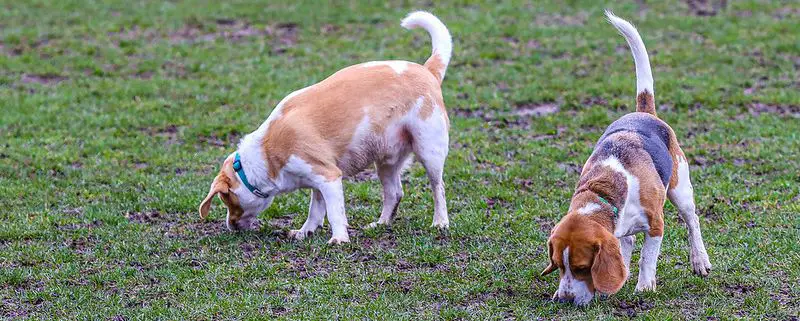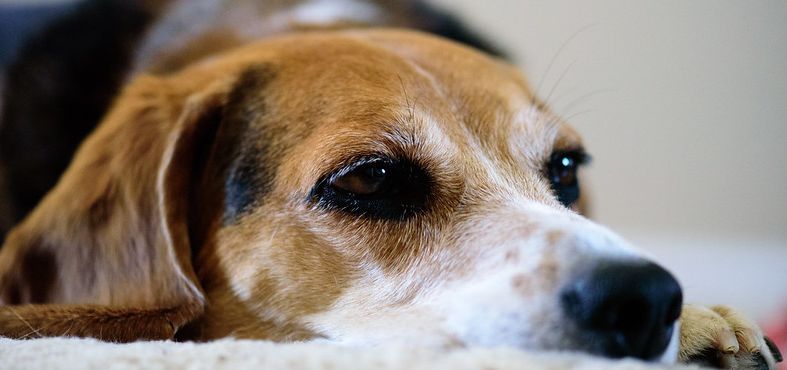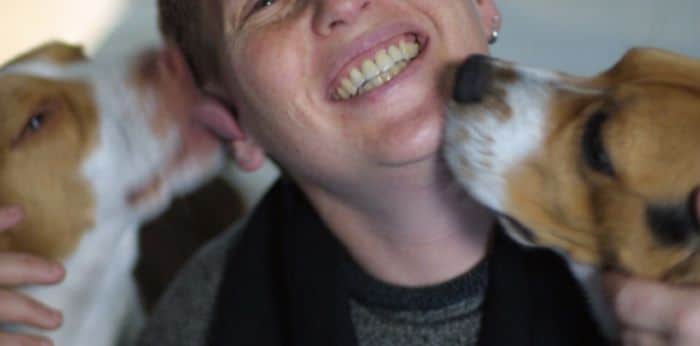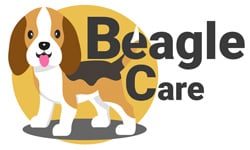Being a dog owner, it’s our responsibility to take proper care of our four-legged pal. And to help our beagle to lead a healthy and happy life, we must have the necessary information about common health problems, their symptoms, and how to avoid them.
To provide authenticate information, I consulted with our local vet, and she suggested all the possible health problems. This article only provides fundamental information on the topic. I do not constitute any pet medical advice, kindly consult a licensed veterinarian for pet medical advice.
Allergies
Allergies are an ill-conceived reaction to foreign substances by the body’s immune system. Allergies are prevalent in all dog breeds. Allergies can be classified into three different categories: Contact Allergy, food allergy, and environmental allergy.
Contact Allergy
Contact Allergies are caused when a beagle comes in contact with something he is allergic to. Common signs for this kind of allergy include excessive itching, coat loss, and nasal discharge.
Dealing with Contact Allergy:
- Your dog may be allergic to the allergens trapped in the carpet of your house. You can always change the entire carpet of your home or use a Certified HEPA vacuum to clean all the allergens from the carpet.
- Another reason could be the chemical in the floor/carpet cleaner that you use. Try getting a hypoallergenic and odorless carpet cleaner.
- A widespread cause of contact allergy is fleas. Beagles can be allergic to the saliva of fleas. Keep your beagle away from unhygienic dog parks.
- Consult a vet.
Home Treatment
- Wash your beagle’s paw every time he comes home from outside.
- Bath your beagle once in a week using an oat-meal anti-itching shampoo.
- Use Conditioner.
Food Allergy
Beagles can either be intolerant or allergic to a particular food. Something to note down is that in most cases, dogs are not allergic to the food, but one of the ingredients used to make that food.
Symptoms:
- Skin Reaction
- Digestive Reaction
Dealing with Food Allergy:
- In most cases, food allergies are caused because of commercial foods. Again, this doesn’t mean that the beagle is allergic to commercial food. Instead, he is just allergic to one of the ingredients used to make that commercial food. The ingredient could be added flavor, preservative, or fillers. The best way to deal with it is to switch to a more premium brand.
- You can even switch to a healthy home-cooked diet.
- Speak to a vet about it.
Environmental Allergy
Some beagles tend to have allergies due to seasonal changes in the environment. Like: summertime allergies are usually caused by pollen or weed and in winter due to dust mite as the house is closed and there is less circulation of fresh air.
Few Common Symptoms:
- Dry coughing
- Sneezing
- Difficult breathing
- Snoring
- Rashes
- Itching, etc.
Dealing with Environmental Allergies
- Try keeping your beagle inside during days of high pollen.
- Wash your pooch’s paw when coming back home.
- Get unscented dog wipes and wipe your beagle’s coat when he comes back home.
- Use the HEPA filter in your air conditioner.
- In summer, when its breezing, do not keep your windows open.
- Wash your bedding and curtains regularly.
- Consult a vet.
Fleas

No matter how much you take care of your beagle, he will catch fleas at least once in his lifetime. Fleas can jump from one dog to another from a distance of 6 feet.
Symptoms
Scratching is the most common symptom of fleas. Even the tiniest flea can cause intense itching to your beagle. If you notice that your beagle has started scratching his ears or any other body part more often, its a high chance that your pooch has fleas.
Coat loss: Few beagles might be allergic to flea saliva, which would cause even more itching and damage to the coat.
You can try looking in the areas that your beagle is unable to reach for itching like his back. If you notice small black dots, then my friend, your pooch has fleas.
Dealing with Fleas
Bath your beagle with a flea shampoo. Make sure to massage your beagle with the shampoo so that it goes deep into the coat to eradicate fleas, fleas’ eggs, larvae, and pupae.
Use a good quality flea comb before and after every bath.
Fleas also jump off the dog’s body in search of another meal. So if your beagle has had fleas, then it’s all over your house. Wash everything you can in your home. Use a vacuum cleaner to suck them from your carpet, chairs, sofas, etc. Try spraying peppermint oil and clove extract around your house.
Preventing Fleas
- As the saying goes, ‘Prevention is better than cure.’ Prevention is the best way to deal with fleas. Beagles are active bread, and they require daily walks and exercise. So it is most recommended that beagles should be on Flea Prevention Medication throughout the year. Preventing fleas is more cost-efficient than curing it.
- Whenever you take your beagle out for a walk or vet, apply anti-flea spray. You can also use natural products that consist of clove extract and peppermint oil.
Vomiting

Your pooch might vomit just because he has eaten something wrong. However, vomiting could also be an indication of something more serious. Your beagle might have swallowed something toxic or could be an early sign of some disorder, in which case he would require medical attention asap.
Sudden Vomiting / Acute Vomiting
If your beagle throws up unexpectedly without any previous health issues, then it is Acute Vomiting. Usually, it’s not anything serious, but just to be safe, have your pooch checked by the vet. Just remember that if acute vomiting happens more than once in 72 hours, then it could be a sign of a health issue.
How to prevent this:
The most common cause of acute vomiting is indigestion. If your pooch eats grass or weed, it will cause irritation in his stomach, and he will throw up. So make sure your pooch doesn’t eat anything wrong. You can try putting a dog muzzle when you take your pal out for a walk.
Limping
There are three primary reasons that could cause beagle to limp:
Reason 1: Injured paw
An injury to the dog’s paw is the most common reason behind limping. Just like humans, dogs could break their bones, sprain their muscles, or tear their ligament. If you notice that your beagle is faltering, the first thing you want to do is check his paws for any sign of injury, burns, or cuts. Sometimes a small stone or a pebble stuck between the paw pads could be the culprit, so make sure you check for it too.
Reason 2: Knee or Hip Injury
There’s a possibility of the slipped kneecap or hip dysplasia due to which the dog is limping.
Reason 3: Kidney Infection
Kidney infection is another severe problem that could be the reason behind a dog’s limping.
Limping could be a sign for some severe health concern, so if you notice your beagle is limping, seek medical help as soon as possible.
Worms

According to Dr. Jerry Klein, AKC’s chief veterinary officer, worms can cause serious health problems if left untreated. The five most common types of worms are heartworms, roundworms, hookworms, tapeworms, and whipworms. Let’s look into each one of them and know how to prevent them.
Tapeworms
Tapeworms attach themself in the dog’s intestine. An adult tapeworm could be as large as 20 inches. These worms suck up nutrients and can result in a lack of growth.
How a Beagle gets Tapeworms: A beagle can get tapeworms by swallowing fleas as fleas can contain tapeworm eggs.
How to spot them: These worms can sometimes be present in the beagle’s bowl.
How to Prevent them: Make sure you regularly deworm your beagle.
Hookworms
Hookworms can prove to be fatal if not treated on time. These worms can poke a hole in blood vessels and suck blood. A heavy infestation of hookworm can cause 5 to 10% of blood loss every day.
How a beagle gets hookworms: A dog may get hookworms if he swallows hookworm larvae, which can be present anywhere, sometimes even on grass. Puppies may also be born with this.
How to spot them: Few of the symptoms of hookworms are vomiting, diarrhea(black or bloody), loss of appetite, weakness.
How to Prevent them: Proper hygiene should be maintained. Beagle’s poop should not be left unattained in the yard. Keep your beagle well-groomed and clean. Hookworms can travel from one agent to another, so keep your dog away from uncleaned dog parks. Take your dog for regular checkups.
Roundworms
Roundworms are 4 inches long, white and look like cooked spaghetti. They live in a dog’s intestine and survive on partially digested food.
How a beagle gets Roundworms: A puppy may be born with roundworms or can get infected by drinking infected mother’s milk. A dog can get these by eating soil that could contain roundworm eggs.
How to spot them: Initially, there are no signs of infestation. Symptoms of getting severely infected with roundworms may include vomiting worms, swollen stomach, and signs of pneumonia.
How to prevent them: Regular deworming is necessary. Put a muzzle on your beagle mouth while taking him for a walk, so he doesn’t chew on the soil.
Heartworms
Heartworms live inside the ventricle of the heart and nearby blood vessels. They could grow up to 14 inches and take over the dog’s body. Heartworms are fatal if not treated on time.
How a beagle gets Heartworms: A beagle may get heartworms via infected mosquito bites.
How to spot them: Early signs include difficulty in breathing, weight loss, vomiting, coughing, weakness.
How to prevent them: There are heartworm prevention medication available.
Ringworms
Ringworms are not really a worm but a type of fungus. These fungi live on the surface of the skin and survive on dead skin tissues.
How a beagle gets Ringworms: Ringworms are very contagious. They are transmitted through direct contact with the infected being. This fungus can infect humans too.
How to spot them: In most cases, there would be visible bald spots on the coat of the dog. If not treated, these spots could grow and result in massive fur loss. If you notice something similar, take your pooch to the vet immediately.
Prevention: Keep your beagle clean and stay away from unhygienic dog parks.
Deworming Schedule
Regular deworming prevents most of these worms, so make sure you don’t miss the schedule. As per our local vet, puppies should be dewormed at 2, 4, 6, & 8 weeks of age, and then at three months old and then four months old, but its recommended that you consult a vet for proper advice regarding the schedule.
Epilepsy

One of the top 5 breeds most prone to Epilepsy is Beagle, and that’s why it is necessary to have some basic understanding of epilepsy. The first epilepsy seizure could usually occur between the age of 1 and 3 years old. Many beagles do well and live a high-quality life even after they are diagnosed with epilepsy.
Symptoms of Epilepsy
The beagle will start acting strange and appear to be non-responsive. In epilepsy seizures, the mind freezes momentarily. The dog might shake, even drool, and do odd moments. He may fall on the ground, and his body may become rigid.
Caring for your beagle during a seizure
- Do not panic if your beagle has an episode of seizure. Beagles are quite sensitive regarding their owner’s mood, so your panicking will just scare them more.
- Make sure you comfort your beagle. Gently hold your beagle and try to comfort him.
- Time the seizure. If the seizure lasts for more than 3 minutes, then your beagle might suffer from overheating. Put some wet towels on his neck, paws, and head.
- Take your beagle to a vet once his seizure ends.
Prevention: The most common form of epilepsy is Primary Epilepsy. The cause of this epilepsy is unknown. It is thought to be passed on genetically. So we can do nothing to prevent it.
Hip dysplasia
In hip dysplasia, the soft tissues that surround the joints of a puppy start to grow abnormally. The bones start moving apart and are not held together. As the puppy grows, the two bones lose contact with each other and cause a problem. Usually, signs do not show until the beagle is in his late adulthood.
Symptoms of Hip Dysplasia
- One leg may appear shorter than other
- The beagle may wobble while walking.
- The beagle may have difficulty rising.
Reasons behind the cause of Hip Dysplasia
- Genetics plays an important role. If one of the parents has hip dysplasia, it is more likely that it will get passed on to their puppies.
- Overweight beagles have higher chances of developing hip dysplasia.
- Over-exercise at a younger age can also be the reason for causing hip dysplasia.
Prevention
- Keep your beagle fit. Do not overfeed him, neither underfeed him. Provide proper nutrients and make your beagle exercise daily.
- If you have a beagle puppy, then make sure you don’t over-exercise him.
Arthritis

There are four types of arthritis: Osteoarthritis, Immune-mediated, Infective, and Idiopathic (unknown cause). The most common type of arthritis in beagles is Osteoarthritis, in which the beagle’s joint becomes inflamed and painful.
Symptoms:
- Super laziness. The beagle would not want to do anything but lye on his bed.
- The beagle would show difficulting in getting or rising. This is worst in the morning and might get better as the day goes.
- The dog may be in pain, and it gets difficult for the owner to recognize it. The dog may not want to move much.
Prevention:
- Maintain a healthy weight of your beagle.
- Take your beagle on walks daily. Regular exercise is a must.
- Try to keep your dog away from actions that might cause injures. Place a canine step or a ramp on the floor if your beagle has a habit of jumping off from the sofa or bed. Limit certain actions like high jumps.
Bad Breath

Beagles are cuddle monsters, and they love to lick our faces, so there’s nothing more irritating than a beagle’s bad breath. Well, we don’t expect good, minty smell from our beagle’s mouth, but we do expect a neutral and non-smelly breath. Apart from being unpleasant, bad breath could be a sign of some serious dental concerns. Also, just to mention, it is typical for a beagle’s breath to smell like his food. Let’s look into some reasons behind beagle’s bad breath:
Reasons behind Bad Breath
Teeth: Leading causes behind bad breaths are plaque, tartar, and dental infection and could be a possible sign of undiagnosed dental issues. The most useful thing you can do to prevent this is to brush your beagle’s teeth daily. This will not only make your beagle’s breath smell good but also keep his teeth shining white.
Eating Poop: If your beagle’s breath smells like poop, then he has probably eaten his own or some other animal’s feces. This is known as coprophagia. Consider it a behavioral issue and try to teach your pooch not to do it.
Dental infection: Beagle could have eaten some foreign object that might have stuck between his teeth or pierce his tongue and inside his cheeks. This could lead to a possible infection, which is making his breath smell terrible. Take him to a vet and have his mouth checked.

